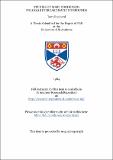Studies of some condensed polyazaheteroaromatic compounds
Abstract
The cyanide induced cyclisation of a number of substituted 2-acetamido-N-(o-nitrobenzylidene)anilines was investigated, resulting in the formation of the appropriate unambiguously substituted quinoxalino[2,3-o]cinnolines. During the course of this study, it was found that by-products were formed during the reaction. These were investigated briefly, and found to be the 5-oxide of the parent quinoxalino[2,3-o]cinnoline, and a 2-amino-3-(o-nitrophenyl)-quinoxaline, thought to be formed by aerial oxidation of intermediates in the cyclisation process. The reaction of a number of substituted quinoxalinocinnolines with gaseous hydrogen halides was investigated. It was found that those quinoxalinocinnolines with no substituent at position 10 underwent chlorination at this site, by apparent replacement of a hydrogen atom with a chlorine atom. When compounds with substituents at position 10 were reacted, chlorination occurred at position 9 in a few cases, failed in a few others, and often gave product mixtures. With the aid of theoretical studies carried out on the chlorination process, a mechanism for chlorination is proposed, that attempts to explain the distribution of products. An investigation was carried out on quinoxalinocinnolines with halogeno-substituents, in order to determine whether the substituents are labile to methoxide ion. It was found that chlorine at position 10 was easily replaced in mono and dichloro-derivatives, while chlorine at position 9 was either resistant to replacement by methoxide, or was much less reactive than the chlorine at position 10. Bromine at position 10 was found to be relatively unreactive, while bromine at position 9 appeared totally inert. The ¹H n.m.r. and mass spectra of the quinoxalino-[2,3-o]cinnolines are discussed in detail.
Type
Thesis, PhD Doctor of Philosophy
Collections
Items in the St Andrews Research Repository are protected by copyright, with all rights reserved, unless otherwise indicated.

